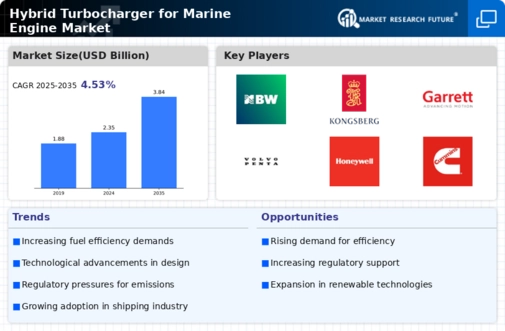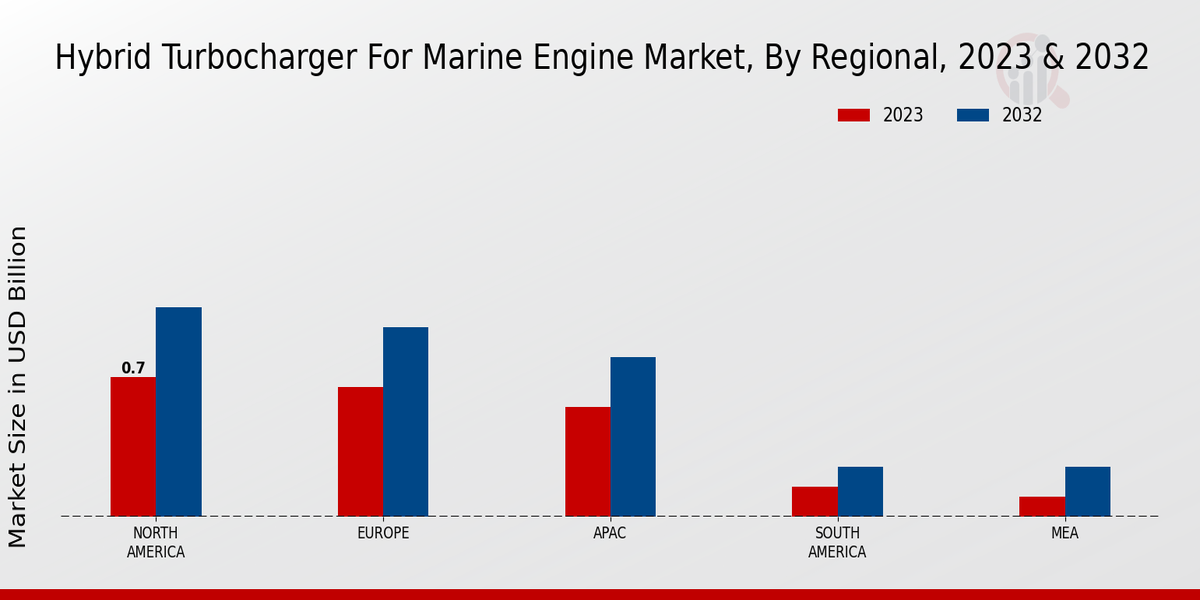Market Growth Projections
The Global Hybrid Turbocharger for Marine Engine Market Industry is poised for substantial growth, with projections indicating a market value of 2.35 USD Billion in 2024 and an anticipated increase to 3.84 USD Billion by 2035. This growth trajectory reflects a compound annual growth rate (CAGR) of 4.56% from 2025 to 2035. Such figures suggest a robust demand for hybrid turbocharger technologies as the maritime sector seeks to enhance efficiency and comply with stringent environmental regulations. The increasing adoption of these systems across various marine applications underscores the market's potential and the ongoing shift towards sustainable practices.
Rising Demand for Energy Efficiency
The Global Hybrid Turbocharger for Marine Engine Market Industry is witnessing a surge in demand for energy-efficient solutions. As marine operators increasingly prioritize fuel economy and reduced emissions, hybrid turbochargers emerge as a viable option. These systems enhance engine performance while minimizing fuel consumption, aligning with global sustainability goals. The market is projected to reach 2.35 USD Billion in 2024, indicating a robust growth trajectory. This trend is further supported by regulatory frameworks promoting cleaner technologies in maritime operations, compelling stakeholders to adopt advanced turbocharging solutions.
Growing Investment in Marine Infrastructure
Investment in marine infrastructure is a crucial driver for the Global Hybrid Turbocharger for Marine Engine Market Industry. As countries expand their port facilities and shipping capabilities, there is a corresponding need for advanced marine engines that can operate efficiently under increased loads. Hybrid turbochargers provide the necessary power and efficiency, making them an attractive option for new builds and retrofits. This trend is evident in regions with booming maritime sectors, where the demand for innovative propulsion solutions is on the rise. The market's growth trajectory is expected to align with these infrastructure developments, further enhancing its potential.
Regulatory Pressure for Emission Reductions
The Global Hybrid Turbocharger for Marine Engine Market Industry is significantly influenced by stringent environmental regulations aimed at reducing maritime emissions. Governments worldwide are implementing policies that mandate lower emissions from marine vessels, driving the adoption of hybrid turbocharger systems. These systems facilitate compliance with regulations such as the International Maritime Organization's (IMO) standards. As a result, shipowners are increasingly investing in hybrid technologies to meet these requirements, thereby propelling market growth. The anticipated compound annual growth rate (CAGR) of 4.56% from 2025 to 2035 underscores the urgency for cleaner marine propulsion solutions.
Technological Advancements in Turbocharging
Technological innovations play a pivotal role in shaping the Global Hybrid Turbocharger for Marine Engine Market Industry. Recent advancements in materials and design have led to more efficient and durable turbochargers. For instance, the integration of variable geometry technology allows for improved performance across various operating conditions. This not only enhances engine efficiency but also contributes to reduced emissions. As manufacturers continue to invest in research and development, the market is expected to grow significantly, with projections indicating a value of 3.84 USD Billion by 2035, reflecting the industry's commitment to innovation.
Increased Focus on Sustainable Shipping Practices
The Global Hybrid Turbocharger for Marine Engine Market Industry is benefiting from a heightened focus on sustainable shipping practices. Stakeholders are increasingly recognizing the importance of adopting technologies that reduce the environmental impact of maritime operations. Hybrid turbochargers, with their ability to improve fuel efficiency and lower emissions, are becoming integral to this transition. Shipping companies are actively seeking solutions that not only comply with regulations but also enhance their corporate sustainability profiles. This shift towards greener practices is likely to drive market growth, as the industry adapts to evolving consumer and regulatory expectations.














